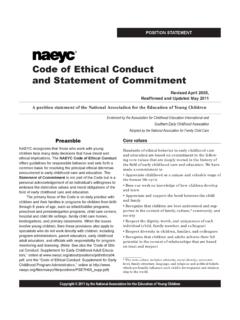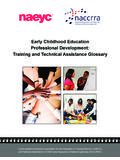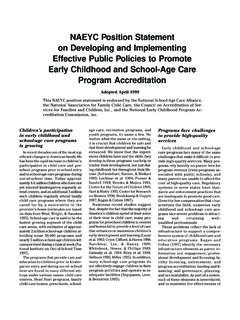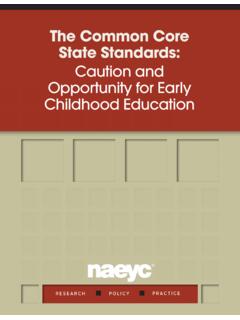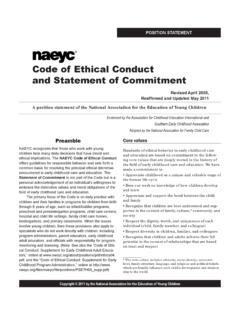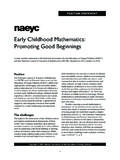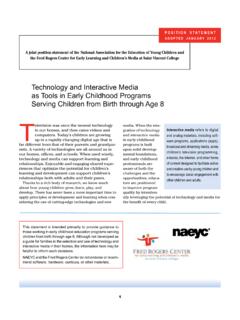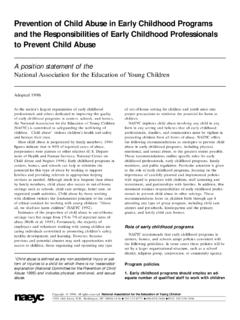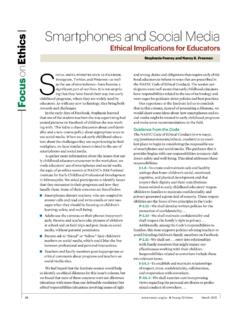Transcription of Early Childhood Education Professional Development ...
1 1 Early Childhood EducationProfessional Development :Training and Technical Assistance GlossaryA joint project of National Association for the Education of Young Children (NAEYC) and National Association of Child Care Resource & Referral Agencies (NACCRRA) 2 Early Childhood Education Professional Development : Training and Technical Assistance Glossary. Copyright 2011 National Association for the Education of Young Children, National Association of Child Care Resource & Referral Agencies. All rights : cover left Mansi, top right NACCRRA, bottom right Schmidt; p. 15 Hands graphic Association for the Education of Young Children (NAEYC)1313 L Street NW, Suite 500 Washington, DC 20005-4101 Phone: 202-232-8777 800-424-2460 Fax: Association of Child Care Resource & Referral Agencies (NACCRRA)1515 N. Courthouse Road, 11th FloorArlington, VA 22201 Phone: 703-341-4100 Fax: Childhood Education Professional Development Training and Technical Assistance GlossaryProfessional preparation and ongoing Professional Development (PD) for the Early Childhood Education workforce is essential to providing high-quality services to children and families.
2 Consistent terminology and definitions related to PD methods, roles, knowledge, and capabilities have emerged as a critical issue for the Early educa-tion field. Recently, states have experienced new Early Childhood Education system chal-lenges and needs related to training and technical assistance (TA). The urgency of these issues grows, particularly as states increase their focus and work on quality improvement activities, including quality rating and improvement systems (QRIS). For example, many states are working to define what training and TA is needed to support successful participation in QRIS, and how it integrates with PD activities and systems; how to determine who can provide training and TA and how; and how to track and count TA as part of an individual s Professional develop- support related efforts, the National Association for the Education of Young Children (NAEYC) and the National Association of Child Care Resource and Referral Agencies (NACCRRA) jointly developed this glossary of Professional Development , training, and technical assistance (TA) terms.
3 Additionally, NAEYC and the Alliance of Early Childhood Teacher Educators (a collaborative effort of the National Association of Early Childhood Teacher Educators and ACCESS Associate Degree Early Childhood Teacher Educators) will continue to explore and develop national educa-tion-related definitions as a companion to this training and TA glossary is composed of global definitions that embrace what NAEYC and NACCRRA believe define the current best practice ideals for training and TA. The defini-tions were developed for those who provide PD, state policy makers, Early Education advocates, and program administrators working to connect PD activities and initiatives 1 Details about the Development process of this training and TA glossary are located in Appendix AssistanceTrainingEducationProfessional Development4into an integrated system. NAEYC and NACCRRA hope the definitions will provide a guide for states to adapt and adjust as needed to meet their specific system(s) needs in clarifying roles and policies, assisting with the related work of determining and sup-porting the knowledge and capabilities of those providing PD, and also in data efforts to count and track all types of PD.
4 We also hope these definitions will help provide common understandings, or starting points, for research and national or cross-state discussions knowing that there are a variety of different models and approaches to each strategy included in this high-level definitions one method of PD delivery is generally predominant in a given situation, these strategies frequently overlap. In fact, best practices in Professional Development delivery include the use of multiple methods. However, in this glossary training and TA methods are defined as discrete processes. This glossary begins with definitions that provide a broad overview of PD context. The resource then defines specific PD methods of train-ing and TA including mentoring, coaching, consultation, advising, and peer-to-peer TA. Two appendices also are included in this resource: Appendix A Technical Assistance Strategies and Appendix B Project Overview and job titles of the individuals who provide PD are many and varied higher Education faculty, trainers, program administrators in their training and TA roles, individual consultants, child care resource and referral training and TA staff, and others.
5 These professionals provide Education , training, and/or TA to individu-als working or preparing to work with young children and their families and those working or preparing to work on behalf of children in training, licensing, resource, and other administrative roles related to Early Childhood Education . While NAEYC, NACCRRA, and the Alliance of Early Childhood Teacher Educators believe that those who provide PD should possess a high level of knowledge and skills and participate in ongoing Professional Development , this glossary does not define the core knowledge and capabilities expected of these professionals. In future work, NAEYC, NACCRRA, and the Alliance of Early Childhood Teacher Educators will explore the core knowledge and capabilities of those who provide Professional Development and what national resources may be helpful to support related state and NACCRRA Training and Technical Assistance Glossary5 Contextual DefinitionsThe Early Childhood Education Workforce includes those working with young children (infants, toddlers, preschoolers, and school-age children in centers, homes, and schools) and their families or on their behalf (in agencies, organizations, institutions of higher edu-cation, etc.)
6 , with a primary mission of supporting children s Development and learning. Early Childhood Education Professional Development is a continuum of learning and support activities designed to prepare individuals for work with and on behalf of young children and their families, as well as ongoing experiences to enhance this work. These opportunities lead to improvements in the knowledge, skills, practices, and dispositions of Early Education professionals. Professional Development encompasses Education , training, and technical of the Early Childhood workforce have college degrees in Early Education , some have degrees in closely related fields, some are enrolled in degree programs, some are taking college courses, some are graduates of technical high schools or technical school programs, some have no previous related Education and almost all of them are engaged in training every year. An individual may engage in all types of PD (educa-tion, training, and TA) over the course of a career.
7 Professional Development helps Early Childhood professionals in all roles progress along diverse career pathways that build and reward increasing knowledge and Professional Development ( Education , training, and TA) should be designed using evidence-based best practices 2; consistent with the principles of adult learning; and structured to promote linkages between research, theory, and practice. address the continuum of young children s abilities and needs. respond to each learner s background (including cultural, linguistic, and ability), experiences, and the current context of her role and Professional goals. include resources to ensure access for Professional Development Plans (IPDPs) are documents that provide a framework connecting various Professional Development experiences to each other and to the common core of knowledge and Professional standards for Early Education professionals. Individual Professional Development plans are designed to create a 2 A decision - making process that integrates the best available research evidence with family and Professional wisdom and values.
8 V. Buysse, V., P. Wesley, P. Snyder, & P. Winton. 2006. Evidence-Based Practice: What Does It Mean for the Early Childhood Field? Young Exceptional Children 9 (4): and NACCRRA Training and Technical Assistance Glossary6holistic approach to building an Early Childhood Professional s capacities and to ensure that individuals remain current regarding knowledge and practices in the field. Individual Professional Development plans promote Professional advancement. They can address career opportunities for those with a goal of pursuing different roles or positions in the field. Individual Professional Development plans require and support individuals taking responsibility for mapping their own Professional Development and career pathway. Individual Professional Development plans can be developed in one of two ways: at the workplace level with review and approval by a supervisor, based on needs and strengths of the individual as identified through self-reflection, performance appraisal, and other information, including program evaluation and improvement processes 3; and at the individual level with guidance from an advisor, consultant, mentor, or other TA provider, with a focus on mapping one s own Professional Development and career pathway.
9 Individuals use their IPDPs on an ongoing basis to remain focused on their profes-sional goals and needs. IPDPs are reviewed and revised as necessary on at least an annual basis, or as pro-fessional goals, Development needs, or PD resources or opportunities change. Individuals review their plans as they reflect on their knowledge, practice, profes-sional Development endeavors, and goals with guidance from an advisor or other TA provider, adult educator, and/or the administrative leadership of the individual s Early Childhood Education professionals should have IPDPs to assist in developing or articulating their career goals, and to guide and inform desired career advancement and decisions regarding PD NAEYC Early Childhood Program Standards and Accreditation Criteria. 2007. Standard and NACCRRA Training and Technical Assistance Glossary7 Training DefinitionsTraining is a learning experience, or series of experiences, specific to an area of inquiry and related set of skills or dispositions, delivered by a Professional (s) with subject matter and adult learning knowledge and skills.
10 A planned sequence of training sessions comprises a training program. Part of Professional Development that builds or enhances the knowledge and com-petencies of Early Childhood Education professionals. Training sessions and programs can focus on information dissemination; compre-hension of content; application of knowledge or skills, and related attitudes and dispositions; analysis or synthesis of content; or a combination of these. All training is strengthened by trusting and respectful interactions. Participants value each other as resources for learning, in addition to the trainer serving in the official leadership role. Because training programs include multiple sessions, they benefit from intentional building of positive relationships between and among trainer(s) and participants. Delivered by an individual or a team, to an individual or a group. Planned and conducted based on the standards of the profession and an assess-ment of individual, group, and/or system needs.
